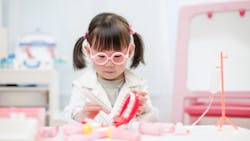Get curious again: How to overcome those blah appointments
I have a confession: I chose dental hygiene because I thought it would be easy. I had worked as a dental assistant in high school and saw the part-time hygienists raising a family, making good money, and leaving work at work. My parents often brought work home, and I didn’t want that.
So off to hygiene school I went, where I quickly realized it was anything but easy—long hours of studying, hunting down patients, and getting crushed by evaluations from professors. But then I graduated, married a guy in the military, and experienced dentistry worldwide. Some of the aspects that drew me to hygiene were true; I worked part-time, made good money, and raised our family. However, I quickly learned that if I left work at work, this job was boring.
As hygienists, we have a choice to make: We can get curious and learn new things, or we can clean teeth. Maybe there’s a place for both? In my career, I have been both. When I’m actively learning, I feel like a true health-care provider, which makes me happier and the job more fulfilling.
Get curious again
It’s estimated that the neurotypical three-year-old asks 300 questions a day. “Why is the sky blue?” “Why do I have to go to bed?” “Why can’t I bite my friend when I’m mad?” At some point in our lives, someone probably got annoyed with all our questions, and we were told to be quiet. So we stopped asking questions, stifled our curiosity, and started trying to be right.
I remember just wanting the answers in hygiene school (heck, I still do). I hated it when my professors would answer my question with a question, like they were quizzing me, just waiting for me to be wrong. But with reflection, I realized those questions were helping me learn to think critically. Each patient, each spicule of calculus, each “yes” on the medical history is an opportunity to review all the options on the bracket table or in our textbook. Was there always a right or wrong answer? Maybe not. Hygiene isn’t as black and white as I envisioned in high school.
All too often, we just want someone to tell us what to do. Years ago, while in Denmark, I saw a sign that said, “I wish I had my pre-internet brain,” and it struck me. Did some of our curiosity, critical thinking, opportunity for collaboration, and desire to experiment die when we could just Google the answer?
We hygienists get a bad rap for lecturing patients about brushing and flossing. It’s like we turn into Charlie Brown’s parents and patients tune us out. In our rush to get through our precious appointment time, we can become a little robotic. We focus on getting it done rather than being curious about each individual patient. (I’m not judging here; this is me 100%.)
I want to offer up a challenge: I dare you (and me) to try something new. Embrace your natural curiosity and change the way you approach patient care. Here are some simple, not-time-consuming options to lose the robot and bring a little critical thinking into your appointments.
Remember the other expert in the room
There are two experts in every examination room: you about oral health, and the patient about their health. Codiagnosis brings the patient into owning their condition and removes you from being the nag or the one who made them bleed. It involves using tools to show the patient their bleeding, plaque, decay, or whatever their condition is. While there are expensive pieces of technology for this, there are even more quick, cheap, and (best of all) fast products to help you on the path to codiagnosis.
Hands down, my favorite product is disclosing solution. You might be thinking, “I haven’t touched that stuff since hygiene school.” It was messy and used to lower my grade, but it has become an invaluable tool to me over the years. The glorious part about this stuff is that the patient gets to see which areas need more attention without getting a lecture from you.
GC Tri Plaque ID Gel from GC America stains plaque different colors depending on how long it’s been there. Pink/red is less than 24 hours, blue/purple is greater than 48 hours, and most telling of all, light blue is acidic (or cavity-causing) plaque. Gone is the excuse that they just ate lunch and didn’t have time to brush. Now patients can take ownership of their homecare. When you work this into your routine at the beginning of the appointment, you’ll have patients who come back proudly declaring you will see no purple today!
Make use of those diagnostics
Like your medical doctor, we have diagnostic tests that help us move beyond the brush-and-floss lecture, elevate our role as health-care professionals, and give patients an objective look at their condition. Blood pressure, salivary diagnostics, and A1C testing are all simple tests we can perform chairside.
When facing a patient with chronic decay or bleeding, diagnostics are a great way to dig into the why behind their disease. For instance, understanding a patient’s saliva flow and quality can give quick clues to their decay and periodontal status. Simply asking a patient if they have dry mouth will not give you an accurate answer, nor will it tell you about the quality of their saliva. GC America’s Saliva-Check Buffer is a simple chairside in-vitro test to check saliva quality, pH, and buffering capacity. Tests like this help patients understand their risk factors and leave them asking you for solutions. No lecture required!
Attend lunch and learns
To provide the best solutions for your patients, you want to stay up-to-date on new products and trends. Understand for most situations, there is not one product or one tool that will solve everything, so become familiar with a wide range of options.
Many companies offer lunch and learns. While they can be commercial, they allow your team to learn about what products and services are available. They’ll often pique your curiosity and get you thinking about how to help your patients in a new way, and can also be an excellent opportunity for some team interaction. They’ll also give you the chance to ask questions and receive samples and discounts.
Get the most out of your CE
While licensed professionals are required to complete a certain number of hours of continuing education, we all know you can phone it in if you want. It’s easy to half-listen to a webinar or take the post-test without watching the course (ask me how I know). At that point, you’re just checking a box, not growing. By tuning out, you miss the opportunity to get excited about all the emerging science and new technologies in the industry.
My suggestion is to find topics that excite you, and try to do some in-person events if you can. Being around like-minded professionals and hearing their successes and struggles can ignite a fire in you like no other. When I attended my first RDH Under One Roof, I left feeling like I could change the world! I had new ideas, new products, and a newfound confidence that I was indeed a prevention specialist.
Stop being afraid to be wrong
This is the toughest one. We hygienists are often perfectionists. We work for dentists who can be demanding. But guess what? We are practicing medicine. No one knows everything! When you go to your medical doctor with an issue, they often say something like, “Let’s try this and come back in 10 days, and we’ll see how it’s working.” Each patient’s condition is so unique to all the systems and life stresses in their world that we can discover options that might help when we experiment—but nothing is guaranteed.
You don’t have to be an expert to implement a new technique or suggest a new product. If you wait until you feel you know it all, you’ll never start. Our profession is changing fast. We are making discoveries around cariology, periodontal disease, oral systemic connections, and so much more. If you need to wait until you’re 100% sure, you’ll be out of date.
So, get out there! Fire up that curiosity, exercise that critical thinking, try out the new products you got or techniques you learned from that course. I double-dog dare you.
Editor's note: This article appeared in the September 2023 print edition of RDH magazine. Dental hygienists in North America are eligible for a complimentary print subscription. Sign up here.
About the Author

Amanda Hill, BSDH, RDH, CDIPC
Amanda Hill, BSDH, RDH, CDIPC, is an enthusiastic speaker, innovative consultant, and award-winning author who brings more than 25 years of clinical dental hygiene and education to dentistry. Recipient of ADS’s Emerging Infection Control Leader award and an active participant with the advisory board for RDH magazine, DentistryIQ, and ADS’s Infection Control in Practice Editorial Review Board and membership committee, Amanda (also known as the Waterline Warrior) strives to make topics in dentistry accurate, accessible, and fun. She can be reached at [email protected].
